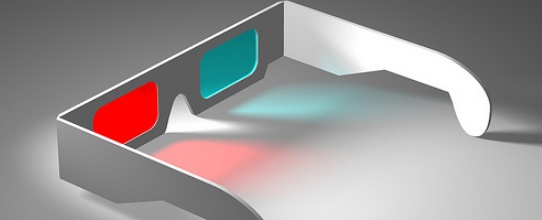Friday Face/Off: 3D Films

“It is better,” said the essayist and moralist Joseph Joubert, “to debate a question without settling it than to settle a question without debating it.” In the spirit of such a great man that we just found out about on Wikipedia, we present you, gentle reader, with the next in our series of debates on the state of modern film.
One of our crack team of writers will present an argument on a subject of their choosing, using their guile, wit and powers of persuasion. Another will then step up to the plate and present a rebuttal, principally consisting of facile name-calling, “yo mama” jokes, pedantry and playground-level sarcasm.
In this week’s Face/Off, the spotlight swings to 3D films. Is the re-emerging trend of 3D-ising every big new film release warranted? Or is it an outdated way to embarrass cinema audiences by forcing them to wear ridiculous glasses for no reason? Whack on your crazy specs and get ready for one crazy ride of intellectual debate. No blue people though. Sorry.
For the Prosecution:

Remember back in the days when 3D was last cool? You’d go to some terrible theme park with your parents in the school holidays and sit in the back of a dank cinema, poking fun at your siblings for looking a right idiot in glasses made of cardboard and cellophane. There’d be a brief period of oohing, aahing and exclamations of, “Look out, the dinosaur’s going to eat you!”, then the lights would come up and you’d move on to the rollercoaster or the laughing clowns. A pleasant enough half an hour’s entertainment (especially for the adults, as it was something that didn’t involve whiplash or nausea), but you’d probably have forgotten all about it on the way home.
Which is why the recent re-emergence of 3D films is so baffling. Sure, technology has improved in leaps and bounds since the days of the ’90s theme park attraction – the beasties look more fearsome, the sound quality is better, and whole worlds can be created on a computer and green-screened into a studio of actors. There’s no question that 3D works better on screen than it did then, but what does it actually add to a film? Can it make a crap or average film good?
The answer, sadly, is no. Take James Cameron’s recent bloated blockbuster Avatar. Yes, the effects were great, and you noticed that even more if you were lucky enough to view the film in 3D. But despite critics waxing lyrical on the beautiful, immersive world of the Na’vi, there was one thing nearly every review mentioned – the fact that the plot and characterisations were thin. While the film has been nominated for Best Picture in this month’s Golden Globes, its actors were curiously missing in the other key categories, most likely due to the fact it’s not very hard to play a brawny hero or a damsel in distress. The fact is, if you don’t identify with a film’s protagonists, if you find the story it’s trying to tell predictable and laughable, it’s not really going to be a good film, and there’s nothing any amount of scary animals looming really close to your face can do about that.
3D effects in film are essentially a sideshow – in a truly beautiful film, like 2009’s Up, they’re not necessary, and in a whizz-bang blockbuster like Avatar, they’re there to distract you from the emptiness of the writing. We’re not nine years old anymore – we know the monster isn’t really going to leap out of the screen and eat us. So really, directors’ time would be better spent making sure they’re actually creating something intelligent that will be remembered well after the lights come up.
For the Defence:

Bored of movies that only entertain you, eh? Tired of plotlines, special effects, shiny shiny Oscar-worthy acting and directing that quickens the heart and sparks joy in the brain? Well, then I guess you’re a bit bored of life. But fret not! 3D is here to bring some magic and joy into a life otherwise dominated by gruel, dyspepsia and chewing tin foil for kicks.
The moviegoing experience has always been evolving, from the first use of special effects (a trick-photography beheading in an 1895 film, fact fans) to the the rise of the modern blockbuster. Cinema’s a medium where anything can happen, and the main part of its appeal is surely the extent to which you can become immersed in a story. The next logical step for verisimilitude – beyond smell-o-vision, obviously – is films that have all the depth of beauty of reality itself. And that, my friends, is where 3D comes into its own.
We’re not arguing here that old-skool 3D was pretty shoddy. Those damn paper glasses that either cut your nose or made you feel dizzy? Screw ’em, they were rubbish. It also wasn’t proper 3D – more of a feeling that characters were creepy moving cardboard cutouts placed about a foot in front of the backdrop. But hey, it must’ve seemed pretty impressive at the time, especially when going to watch such cult classics as Cat-Women of the Moon (1954), Gorilla at Large (1954) and Robot Monster (1954).
Luckily, we don’t have to put up with any of that passé Fifties guff any more. No longer do we have to look like David Bowie with those weird glasses on – nope, the funky new polarised glasses make the audience look like an audience comprised solely of Blues Brothers and Reservoir Dogs. And if that ain’t groovy, what is?
We’ll tell you what is: The new era of 3D effects, that’s what.
Yup, you can say goodbye to the world of cardboard cut-outs. Now we get true depth and a real sense of tangibility from our 3D experience. My esteemed colleague mentioned Avatar in their sterling – yet misguided – attempt to defame the modern resurgence of 3D, which is almost like arguing against drowning by tying bricks to your feet. Avatar is easily the best ambassador for 3D we’ve seen in recent years, from the various Pandoran beasties popping out of the screen to subtler uses, such as cinders from the Hometree floating down among the dispossessed Na’vi. That’s right: we even get 3D metaphors. And so what if the story in Avatar was a bit flaky? The 3D was immense, and with technologies developing as they inevitably do, thing can only get better.
Especially with the advent of smell-o-vision.





Recent Comments